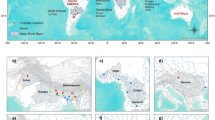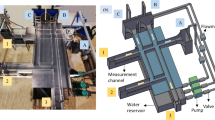Abstract
Floods are one of the most frequent and devastating natural disasters for human communities. Currently, flood response management globally commonly relies on hydrodynamic models for accurate simulation of complex flow patterns of flood events and to provide information on flood risks. However, the computational demand of hydrodynamic models means that they cannot be deployed usefully for real-time flood inundation forecasting over large domains or for situations where simulations need to be run repeatedly for planning purposes. Here we introduce a new modelling approach that supercharges hydrodynamic models for speed while maintaining high accuracy. We found that spatiotemporal patterns of flood inundation simulated using an extremely simplified (and hence superfast) hydrodynamic model can be mathematically transformed to reproduce the results from a high-resolution model. We exploited the efficacy of this transformation to provide high-resolution and accurate flood inundation predictions in a few seconds rather than the many hours required by conventional high-resolution hydrodynamic models, which represents an important practical advancement towards saving lives and protecting assets during flood emergencies.
This is a preview of subscription content, access via your institution
Access options
Subscribe to this journal
Receive 12 digital issues and online access to articles
$99.00 per year
only $8.25 per issue
Buy this article
- Purchase on Springer Link
- Instant access to full article PDF
Prices may be subject to local taxes which are calculated during checkout




Similar content being viewed by others
Data availability
The low- and high-fidelity model results used to generate the data in this paper are available from the digital data repository in Fraehr53. The high-fidelity model dataset for the Chowilla floodplain study site was retrieved from the data repository in Fraehr54, and the high-fidelity model dataset for the Burnett River study site was made available by Zhou et al.24.
Code availability
The LSG model framework is coded in Python programming language (v.3.9). The custom code used for data preparation, EOF analysis, LSG model training and prediction, as well as postprocessing, is available from the digital data repository in Fraehr53.
References
Guha-Sapir, D., Below, R. & Hoyois, P. EM-DAT: The CRED/OFDA International Disaster Database (Univ. Catholique de Louvain, accessed 16 February 2023); www.emdat.be
Bates, P. D. Flood inundation prediction. Annu. Rev. Fluid Mech. 54, 287–315 (2022).
Teng, J. et al. Flood inundation modelling: a review of methods, recent advances and uncertainty analysis. Environ. Model. Softw. 90, 201–216 (2017).
Wang, W., Wang, Q. J., Nathan, R. & Velasco-Forero, C. Rapid prediction of flood inundation by interpolation between flood library maps for real-time applications. J. Hydrol. 609, 127735 (2022).
Yang, K., Paramygin, V. A. & Sheng, Y. P. A rapid forecasting and mapping system of storm surge and coastal flooding. Weather Forecast. 35, 1663–1681 (2020).
Linsley, R. K. Flood estimates: how good are they? Water Resour. Res. 22, 159S–164S (1986).
IPCC Climate Change 2021: The Physical Science Basis (eds. Masson-Delmotte, V. et al.) (Cambridge Univ. Press, 2021).
Coelho, G. D. A. et al. Potential impacts of future extreme precipitation changes on flood engineering design across the contiguous United States. Water Resour. Res. 58, e2021WR031432 (2022).
Schlef, K. E. et al. Incorporating non-stationarity from climate change into rainfall frequency and intensity-duration-frequency (IDF) curves. J. Hydrol. 616, 128757 (2023).
Wasko, C. et al. Incorporating climate change in flood estimation guidance. Phil. Trans. R. Soc. A 379, 20190548 (2021).
Luo, P. et al. Urban flood numerical simulation: research, methods and future perspectives. Environ. Model. Softw. 156, 105478 (2022).
Neal, J., Fewtrell, T. & Trigg, M. Parallelisation of storage cell flood models using OpenMP. Environ. Model. Softw. 24, 872–877 (2009).
Sanders, B. F. & Schubert, J. E. PRIMo: parallel raster inundation model. Adv. Water Resour. 126, 79–95 (2019).
Schubert, J. E., Luke, A., AghaKouchak, A. & Sanders, B. F. A framework for mechanistic flood inundation forecasting at the metropolitan scale. Water Resour. Res. 58, e2021WR031279 (2022).
Ming, X., Liang, Q., Xia, X., Li, D. & Fowler, H. Real‐time flood forecasting based on a high‐performance 2‐D hydrodynamic model and numerical weatherpredictions. Water Resour. Res. 56, e2019WR025583 (2020).
Morales-Hernández, M. et al. TRITON: a Multi-GPU open source 2D hydrodynamic flood model. Environ. Model. Softw. 141, 105034 (2021).
Buttinger-Kreuzhuber, A. et al. An integrated GPU-accelerated modeling framework for high-resolution simulations of rural and urban flash floods. Environ. Model.Softw. 156, 105480 (2022).
Bates, P. D. & De Roo, A. P. J. A simple raster-based model for flood inundation simulation. J. Hydrol. 236, 54–77 (2000).
Sridharan, B., Bates, P. D., Sen, D. & Kuiry, S. N. Local-inertial shallow water model on unstructured triangular grids. Adv. Water Resour. 152, 103930 (2021).
Wu, W. Y. et al. Ensemble flood forecasting: current status and future opportunities. Wiley Interdiscip. Rev. Water 7, e1432 (2020).
Merz, B. et al. Impact forecasting to support emergency management of natural hazards. Rev. Geophys. 58, e2020RG000704 (2020).
Kabir, S., Patidar, S. & Pender, G. A machine learning approach for forecasting and visualising flood inundation information. Proc. Inst. Civil. Eng. Water Manag. 174, 27–41 (2021).
Kabir, S. et al. A deep convolutional neural network model for rapid prediction of fluvial flood inundation. J. Hydrol. 590, 125481 (2020).
Zhou, Y., Wu, W., Nathan, R. & Wang, Q. J. A rapid flood inundation modelling framework using deep learning with spatial reduction and reconstruction. Environ. Model. Softw. 143, 105112 (2021).
Ivanov, V. Y. et al. Breaking down the computational barriers to real‐time urban flood forecasting. Geophys. Res. Lett. 48, e2021GL093585 (2021).
Chu, H. B., Wu, W. Y., Wang, Q. J., Nathan, R. & Wei, J. H. An ANN-based emulation modelling framework for flood inundation modelling: application, challenges and future directions. Environ. Model. Softw. 124, 104587 (2020).
Donnelly, J., Abolfathi, S., Pearson, J., Chatrabgoun, O. & Daneshkhah, A. Gaussian process emulation of spatio-temporal outputs of a 2D inland flood model. Water Res. 225, 119100 (2022).
Xie, S. et al. Artificial neural network based hybrid modeling approach for flood inundation modeling. J. Hydrol. 592, 125605 (2021).
Razavi, S., Tolson, B. A. & Burn, D. H. Review of surrogate modeling in water resources. Water Resour. Res. https://doi.org/10.1029/2011WR011527 (2012).
Liu, H. T., Ong, Y. S., Cai, J. F. & Wang, Y. Cope with diverse data structures in multi-fidelity modeling: a Gaussian process method. Eng. Appl. Artif. Intell. 67, 211–225 (2018).
Apel, H., Vorogushyn, S. & Merz, B. Brief communication: impact forecasting could substantially improve the emergency management of deadly floods: case study July 2021 floods in Germany. Nat. Hazards Earth Syst. Sci. 22, 3005–3014 (2022).
Asher, M. J., Croke, B. F. W., Jakeman, A. J. & Peeters, L. J. M. A review of surrogate models and their application to groundwater modeling. Water Resour. Res. 51, 5957–5973 (2015).
Willis, T., Wright, N. & Sleigh, A. Systematic analysis of uncertainty in 2D flood inundation models. Environ. Model. Softw. 122, 104520 (2019).
Fraehr, N., Wang, Q. J., Wu, W. & Nathan, R. Upskilling low‐fidelity hydrodynamic models of flood inundation through spatial analysis and Gaussian process learning. Water Resour. Res. 58, e2022WR032248 (2022).
Fraehr, N., Wang, Q. J., Wu, W. & Nathan, R. Development of a fast and accurate hybrid model for floodplain inundation simulations. Water Resour. Res. 59, e2022WR033836 (2023).
Carreau, J. & Guinot, V. A PCA spatial pattern based artificial neural network downscaling model for urban flood hazard assessment. Adv. Water Resour. 147, 103821 (2021).
2D Modeling User’s Manual (US Army Corps of Engineers, 2021); https://www.hec.usace.army.mil/confluence/rasdocs/r2dum/6.2
Hunter, N. M., Bates, P. D., Horritt, M. S. & Wilson, M. D. Simple spatially-distributed models for predicting flood inundation: a review. Geomorphology 90, 208–225 (2007).
Mudashiru, R. B., Sabtu, N., Abustan, I. & Balogun, W. Flood hazard mapping methods: a review. J. Hydrol. 603, 126846 (2021).
Nathan, R. et al. Impact of natural variability on design flood flows and levels. In Proc. 37th Hydrology & Water Resources Symposium 2016: Water, Infrastructure and the Environment 335–345 (Engineers Australia, 2016); https://www.tuflow.com/media/5014/2016-impact-of-natural-variability-on-design-flood-flows-and-levels-nathan-et-al-hwrs-nz.pdf
Guan, M., Guo, K., Yan, H. & Wright, N. Bottom-up multilevel flood hazard mapping by integrated inundation modelling in data scarce cities. J. Hydrol. 617, 129114 (2023).
Casulli, V. A high-resolution wetting and drying algorithm for free-surface hydrodynamics. Int. J. Numer. Methods Fluids 60, 391–408 (2009).
Casulli, V. Computational grid, subgrid, and pixels. Int. J. Numer. Methods Fluids 90, 140–155 (2019).
Bomers, A., Schielen, R. M. J. & Hulscher, S. J. M. H. The influence of grid shape and grid size on hydraulic river modelling performance. Environ. Fluid Mech. 19, 1273–1294 (2019).
Chowilla Report Card 2021–22 (Murray–Darling Basin Authority, 2023); https://www.mdba.gov.au/climate-and-river-health/water-environment/progress-and-outcomes/chowilla-report-card-2021-22
Environmental Watering and Monitoring (South Australia, Department for Environment and Water, 2022); https://www.environment.sa.gov.au/topics/river-murray/improving-river-health/wetlands-and-floodplains/chowilla-floodplain/environmental-watering-and-monitoring
Water Data Online (Australian Government, Bureau of Meteorology, 2022); http://www.bom.gov.au/waterdata/
Huxley, C. & Syme, B. TUFLOW GPU – best practice advice for hydrologic and hydraulic model simulations. TUFLOW https://www.tuflow.com/media/5015/2016-tuflow-gpu-best-practice-advice-for-hydrologic-and-hydraulic-model-simulations-huxley-et-al-hwrs-nz.pdf (2016).
Chang, C. H. et al. Hindcast and forecast of daily inundation extents using satellite SAR and altimetry data with rotated empirical orthogonal function analysis: case study in Tonle Sap Lake Floodplain. Remote Sens. Environ. 241, 111732 (2020).
Lin, Q., Leandro, J., Gerber, S. & Disse, M. Multistep flood inundation forecasts with resilient backpropagation neural networks: Kulmbach case study. Water 12, 3568 (2020).
Altenau, E. H., Pavelsky, T. M., Bates, P. D. & Neal, J. C. The effects of spatial resolution and dimensionality on modeling regional‐scale hydraulics in a multichannel river. Water Resour. Res. 53, 1683–1701 (2017).
Schaefer, J. T. The critical success index as an indicator of warning skill. Weather Forecast. 5, 570–575 (1990).
Fraehr, N. Dataset for LSG Models for the Chowilla Floodplain and Burnett River v.1 (Univ. of Melbourne, 2023); https://melbourne.figshare.com/articles/dataset/Dataset_for_LSG_models_for_the_Chowilla_floodplain_and_Burnett_River_/22290850
Fraehr, N. Data from HEC-RAS Models for Training and Validation in ‘Development of a Fast and Accurate Hybrid Model for Floodplain Inundation Simulations’ v.2 (Univ. of Melbourne, 2023); https://melbourne.figshare.com/articles/dataset/Data_from_HEC-RAS_models_for_training_and_validation_in_Development_of_a_fast_and_accurate_hybrid_model_for_floodplain_inundation_simulations_/21235782
Sanders, B. F. et al. Collaborative modeling with fine-resolution data enhances flood awareness, minimizes differences in flood perception, and produces actionable flood maps. Earths Future 8, e2019EF001391 (2020).
Acknowledgements
N.F. acknowledges support from The University of Melbourne via the Melbourne Research Scholarship, and W.W. acknowledges support from the Australian Research Council via the Discovery Early Career Researcher Award (no. DE210100117). We thank SunWater and the Murray–Darling Basin Authority for their permission to use the case studies for the Burnett River and Chowilla floodplain, respectively. We thank Y. Zhou for making high-fidelity model results available for the Burnett River case study, and BMT for providing a TUFLOW licence to conduct TUFLOW simulations.
Author information
Authors and Affiliations
Contributions
N.F., Q.J.W., W.W. and R.N. conceived the study conceptualization. N.F. built and ran the hydrodynamic models, developed the codebase, performed data analysis and created visualizations. The methodology was developed by N.F., Q.J.W., W.W. and R.N., with N.F. and Q.J.W. devising the evaluation metrics. All authors contributed to writing, editing and review.
Corresponding authors
Ethics declarations
Competing interests
The authors declare no competing interests.
Peer review
Peer review information
Nature Water thanks Gustavo Coelho and Tom Wills for their contribution to the peer review of this work.
Additional information
Publisher’s note Springer Nature remains neutral with regard to jurisdictional claims in published maps and institutional affiliations.
Rights and permissions
Springer Nature or its licensor (e.g. a society or other partner) holds exclusive rights to this article under a publishing agreement with the author(s) or other rightsholder(s); author self-archiving of the accepted manuscript version of this article is solely governed by the terms of such publishing agreement and applicable law.
About this article
Cite this article
Fraehr, N., Wang, Q.J., Wu, W. et al. Supercharging hydrodynamic inundation models for instant flood insight. Nat Water 1, 835–843 (2023). https://doi.org/10.1038/s44221-023-00132-2
Received:
Accepted:
Published:
Issue Date:
DOI: https://doi.org/10.1038/s44221-023-00132-2
This article is cited by
-
High-resolution impact-based early warning system for riverine flooding
Nature Communications (2024)



